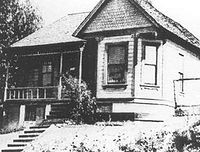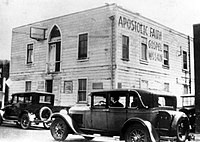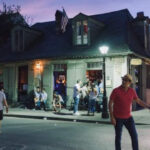The Azusa Street Revival, unfolding from 1906 to 1915 in Los Angeles, California, stands as a monumental revival meeting and the wellspring of the global Pentecostal movement. Spearheaded by William J. Seymour, an African American preacher, this Pentecostal outpouring began humbly on April 14, 1906, and stretched far beyond its initial timeframe, deeply impacting 20th-century Christianity. The revival was marked by fervent spiritual experiences, manifesting as miracles, dynamic worship characterized by speaking in tongues, and an unprecedented level of interracial unity for the era. While facing criticism from both mainstream media and Christian theologians due to its unconventional practices, the Azusa Street Revival is now widely recognized as the pivotal catalyst for the worldwide expansion of Pentecostalism.
Background to the Revival
Echoes of Wales: The Welsh Revival
The seeds of the Azusa Street Revival were sown in an atmosphere of heightened spiritual anticipation, partly fueled by the Welsh Revival of 1904-1905. This earlier revival witnessed an estimated 100,000 individuals in Wales embracing Christianity, an event interpreted by many evangelical Christians globally as a sign of impending fulfillment of biblical prophecy, particularly from the book of Joel 2:23–29. Joseph Smale, the pastor of First Baptist Church in Los Angeles, was so moved by reports of the Welsh Revival that he traveled to Wales to witness it firsthand. Upon his return to Los Angeles, Smale endeavoured to spark a similar spiritual awakening within his own congregation. Though his initial efforts were short-lived, Smale’s passion persisted, leading him to establish the First New Testament Church, where he continued to pursue revival.
Concurrently, smaller revivals were breaking out across the United States in states like Minnesota, North Carolina, and Texas. These localized movements were characterized by phenomena such as speaking in tongues, reports of supernatural healings, and profound transformations in personal conduct. As news of these events spread, a growing number of evangelicals throughout the United States began to earnestly pray for similar revivals in their own communities, setting the stage for what would become the Azusa Street outpouring.
Los Angeles: A City Ready for Revival
In 1905, William J. Seymour, a 34-year-old African American preacher and former student of Pentecostal pioneer Charles Parham, served as interim pastor at a small holiness church in Houston, Texas. Neely Terry, a member of a Los Angeles holiness church led by Julia Hutchins, visited family in Houston in late 1905. During her visit, she attended Seymour’s church and was deeply impressed by his sermons on the baptism of the Holy Spirit evidenced by speaking in tongues, even though Seymour himself had not yet personally experienced this phenomenon. Upon returning to Los Angeles, Terry advocated for Seymour to be invited to preach at her local church.
Seymour accepted the invitation in February 1906 for a month-long visit, receiving both financial support and a blessing from Parham. Arriving in Los Angeles on February 22, 1906, Seymour began preaching within two days at Julia Hutchins’ church, located at the corner of Ninth Street and Santa Fe Avenue. His initial sermons emphasized speaking in tongues as the primary biblical sign of the baptism in the Holy Spirit. However, this message was met with resistance. By Sunday, March 4, Hutchins had locked the church doors, rejecting Seymour’s teachings, largely because he had not yet personally experienced the spiritual baptism he preached about. The Holiness Church Association of Southern California, with which Hutchins’ church was affiliated, also condemned Seymour’s message. Despite this rejection from church leadership, some members of Hutchins’ congregation were receptive to Seymour’s preaching. He was invited to stay at the home of Edward S. Lee, a church member, and began conducting Bible studies and prayer meetings there.
The Bonnie Brae Street Outpouring
Seymour and his growing group of followers soon relocated to the residence of Richard and Ruth Asberry at 214 North Bonnie Brae Street. Notably, white families from local holiness churches also began to join the meetings. The group gathered regularly, praying fervently to receive the baptism of the Holy Spirit. On April 9, 1906, after five weeks of Seymour’s preaching and intense prayer, and during a 10-day fast, Edward S. Lee experienced speaking in tongues for the first time. At the subsequent meeting, Seymour shared Lee’s testimony and delivered a sermon based on Acts 2:4. Soon after, six others, including Jennie Moore, who would later become Seymour’s wife, also began to speak in tongues. On April 12, Seymour himself experienced speaking in tongues after a night of prayer.
News of the extraordinary events at North Bonnie Brae Street spread rapidly throughout the city, attracting African American, Latino, and white residents alike. Nightly, speakers addressed the burgeoning crowds of curious onlookers from the front porch of the Asberry home. Attendees came from diverse socioeconomic and religious backgrounds. Even Julia Hutchins eventually experienced speaking in tongues, and her entire congregation began attending the Bonnie Brae meetings. The crowds swelled, filled with people speaking in tongues, shouting, singing, and weeping. Eventually, the sheer weight of the crowd caused the front porch to collapse, necessitating the search for a larger, more permanent meeting location. A neighbor described the atmosphere at 214 North Bonnie Brae:
They shouted three days and three nights. It was Easter season. The people came from everywhere. By the next morning there was no way of getting near the house. As people came in they would fall under God’s power; and the whole city was stirred. They shouted until the foundation of the house gave way, but no one was hurt.
 The house at 214 North Bonnie Brae Street, Los Angeles, the initial location of the Azusa Street Revival meetings before moving to Azusa Street.
The house at 214 North Bonnie Brae Street, Los Angeles, the initial location of the Azusa Street Revival meetings before moving to Azusa Street.
The Move to Azusa Street
The Bonnie Brae Street group found a suitable building at 312 Azusa Street in downtown Los Angeles. This building, originally constructed as an African Methodist Episcopal Church in what was then a predominantly black area, was available for rent at just $8.00 per month. By this time, the area had become a run-down part of town, and a local newspaper derisively referred to the building as a “tumble down shack”. After the church relocated, the building had been used for various purposes, including a wholesale house, warehouse, lumberyard, stockyards, tombstone shop, and most recently, a stable with upstairs rooms for rent. It was a simple, rectangular structure with a flat roof, approximately 60 feet long and 40 feet wide. The only remaining indication of its prior religious use was a single gothic-style window above the main entrance.
The interior of the ground floor was a large, barn-like room littered with discarded lumber and plaster. Despite its condition, the space was secured and cleaned for services. The first meeting at 312 Azusa Street took place on April 14, 1906. Church services were held on the ground floor, with benches arranged in a rectangular pattern, some made from planks placed on empty nail kegs. The ceiling was low, only eight feet high, precluding an elevated platform. Initially, there was no pulpit. Frank Bartleman, an early participant, recalled Seymour often sitting behind two stacked shoe boxes, keeping his head inside the top box in prayer throughout the meetings, emphasizing the humility of the setting: “In that old building, with its low rafters and bare floors…”
The second floor of the now-named Apostolic Faith Mission housed an office and living quarters for Seymour and his wife Jennie, along with other residents. A large prayer room on the second floor accommodated overflow from the altar services downstairs. This prayer room was furnished with simple chairs and benches constructed from redwood planks. By mid-May 1906, the mission at 312 Azusa Street was drawing crowds estimated between 300 and 1,500 people, all attempting to fit into the repurposed building. Adding to the humble atmosphere, flies, remnants from the building’s recent use as a stable, were a constant presence. People from remarkably diverse backgrounds converged to worship: men, women, children, people of color and white individuals, rich and poor, educated and uneducated. Skeptics and genuine seekers alike flocked to Los Angeles, drawn by reports of the extraordinary events. The interracial nature of the gatherings and the prominent roles of women in leadership were particularly noteworthy, especially considering the pervasive racial segregation of the “Jim Crow” era and the fact that women were still fourteen years away from gaining suffrage in the United States.
 The Apostolic Faith Mission at 312 Azusa Street, the epicenter of the Pentecostal movement and a famous street revival location.
The Apostolic Faith Mission at 312 Azusa Street, the epicenter of the Pentecostal movement and a famous street revival location.
Services and the Culture of Worship
Worship services at 312 Azusa Street were frequent and spontaneous, often continuing nearly around the clock. The revival attracted individuals from various denominations, including members of the Holiness Movement, Baptists, Mennonites, Quakers, and Presbyterians. An observer described the services:
No instruments of music are used. None are needed. No choir- the angels have been heard by some in the spirit. No collections are taken. No bills have been posted to advertise the meetings. No church organization is back of it. All who are in touch with God realize as soon as they enter the meetings that the Holy Ghost is the leader.
In stark contrast, the Los Angeles Times offered a critical and sensationalized portrayal:
Meetings are held in a tumble-down shack on Azusa Street, and the devotees of the weird doctrine practice the most fanatical rites, preach the wildest theories and work themselves into a state of mad excitement in their peculiar zeal. Colored people and a sprinkling of whites compose the congregation, and night is made hideous in the neighborhood by the howlings of the worshippers, who spend hours swaying forth and back in a nerve racking attitude of prayer and supplication. They claim to have the “gift of tongues” and be able to understand the babel.
Charles Parham, Seymour’s former mentor, also voiced harsh criticism, reflecting the racial prejudices of the time and his theological disagreements with the direction of the revival. Despite external criticisms, the Apostolic Faith publication, produced by the mission, documented the transformative impact on visitors:
Proud, well-dressed preachers came to ‘investigate’. Soon their high looks were replaced with wonder, then conviction comes, and very often you will find them in a short time wallowing on the dirty floor, asking God to forgive them and make them as little children.
Eyewitness accounts detailed remarkable occurrences, including the restoration of sight to the blind, instant healing from diseases, and uneducated black members miraculously speaking to immigrants in German, Yiddish, and Spanish, with others interpreting these languages into English through “supernatural ability.”
Singing was often spontaneous and a cappella, sometimes in tongues. Periods of silence were also common. Attendees were frequently slain in the Spirit. Testimonies were shared by visitors and read aloud from letters sent to the mission. Prayers were offered for the gift of tongues, for the sick, for missionaries, and for various needs submitted by attendees or through mail. Spontaneous preaching and altar calls for salvation, sanctification, and Holy Spirit baptism were regular features. Lawrence Catley, whose family participated in the revival, noted that preaching often consisted of Seymour opening the Bible and allowing worshippers to step forward to preach or testify as led by the Holy Spirit. Throughout the services, many people engaged in continuous, vocal expressions of worship. Although offerings were never solicited, a receptacle was placed near the door for those who wished to support the revival financially. The core membership of the Azusa Street Mission remained relatively small, around 50–60 individuals, but over the years, hundreds of thousands visited or stayed temporarily, contributing to its far-reaching influence.
The Azusa Street Revival, born in humble circumstances and characterized by fervent,Spirit-led worship, became a watershed moment in Christian history. Its emphasis on direct spiritual experience, interracial fellowship, and the empowering of ordinary believers ignited a global movement that continues to shape the landscape of Christianity today, solidifying its place as a truly transformative street revival.

